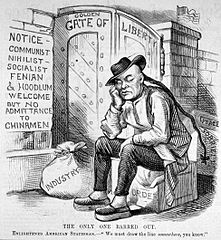[UPDATE: I have added a new blog post titled gains from migration: GDP versus surplus that covers an issue that I didn’t adequately address in this blog post: that even though the contribution to GDP is largely made directly through the migrant, the “benefits” of this, in terms of the social surplus, are captured more broadly.]
Critics of immigration generally spend very little effort critiquing the strongest quantitative argument in favor of open borders: that they would result in a one-time increase in world GDP by 50-150%, or, in short, slogan form, double world GDP (the canonical literature review is this paper by Michael Clemens and the slogan “double world GDP” seems to have first been used in this blog post by Bryan Caplan). Many of these critics are citizenists, and frankly couldn’t care less about world GDP. But others have scoffed at these estimates without providing a clear-cut argument against them.
To my knowledge, the best critique of these estimates is expressed in a series of blog comments by Ghost of Christmas Past, a commenter on EconLog. The most complete versions of the critique are in this comment by Ghost of Christmas Past on Caplan’s “National Egoism” post and this comment by Ghost of Christmas Past on Caplan’s persuasion bleg post. I would like to provide a detailed point-by-point response to Ghost of Christmas Past’s critique. Prior to that, however, I need to establish more clearly just where the “double world GDP” estimates come from and what I think are the weaknesses of these estimates.
The first question: how are these world GDP estimates calculated?
One of the things that Ghost of Christmas Past glosses over in his/her critique is that the “double world GDP” estimate is not simply the estimate made by Michael Clemens. Rather, Clemens does a literature review and considers the many different estimates, showing that they are in a range of 50-150%. The back-of-the-envelope estimate by Clemens is more of a sanity check of the following sort: okay, assume that gains are half of what we observe today, how much can that give us? Then, Clemens goes over the various aspects that go into computing these estimates and the degree of uncertainty behind each of these factors. For those who don’t have the time to read Clemens’ paper, a quick list of the factors that would need to be considered, solely from the migration of labor, are: the effect on migrants, the effect on competing labor, employers, and consumers in the target country, and the effect on competing labor, employers, and consumers in the source country. Of course, when people move, it’s a migration of both labor and consumers, as well as, possibly, a migration of capital. This would further complicate the analysis.
The overall story behind the double world GDP estimate is that the first-order effect on migrants — aka the benefit to migrants — is huge, thanks to the place premium. In other words, migrants gain a lot by migrating. What they do with these gains (for instance, whether they send part of the money to their home countries as remittances, or save and invest in businesses in the country they migrated to) is not directly relevant to the GDP gain estimate.
What about the gains and losses by others, including competing labor, employers, and consumers, in the source and target countries? These gains and losses could both be important, but they are quantitatively likely to be substantially smaller than the gains to migrants. There could be considerable debate about the sign of these effects. For instance, the debate surrounding the suppression of wages of natives is about the extent to which competition in the labor market from immigrants drives down native wages. Pessimists believe that the driving-down effect from three decades of immigration to the United States has been about 4.8% for high school dropouts in the United States, and closer to zero for other categories of workers. Optimists see the effects as zero or slightly positive at current levels of immigration to the United States (more US-specific stuff at the link). Both optimists and pessimists believe that substantially more open borders would probably lead to a bigger decline in native wages, though less so in the long term than the short term. The overall magnitude and sign of the effects is up for empirical debate. Note: Even with a modest wage decline, natives may still be better off if price declines and the expansion in the range of consumption options makes up for this decline. They may also be better off as employers and land-owners. It’s only a small fraction of natives who are unambiguously likely to be worse off — those who depend primarily on wages (i.e., don’t own land), work in unskilled jobs that directly compete with unskilled immigrant labor, and don’t value the expanded range of consumption possible through immigration.
So how does this fit in with the “double world GDP” estimate arguments? The crux is that these gains and losses figure as rounding errors compared to the huge gains experienced by migrants. Continue reading The story behind the “double world GDP” estimates →

